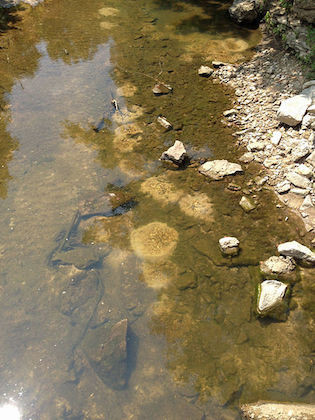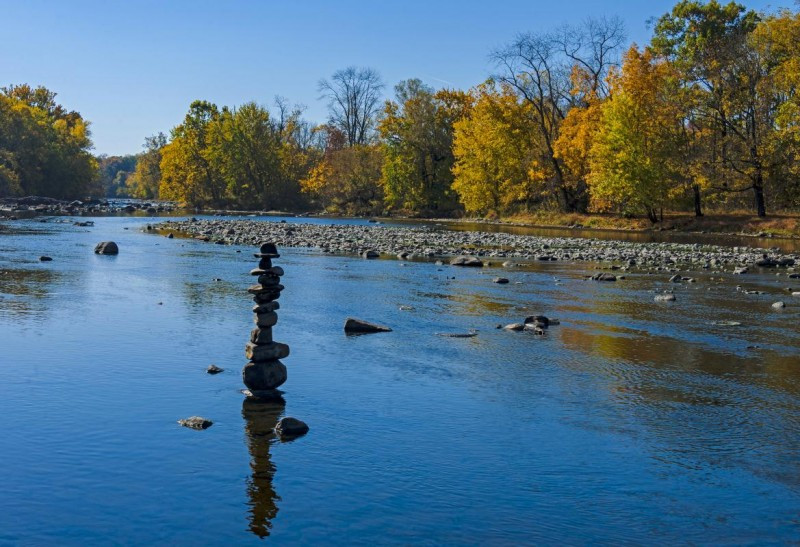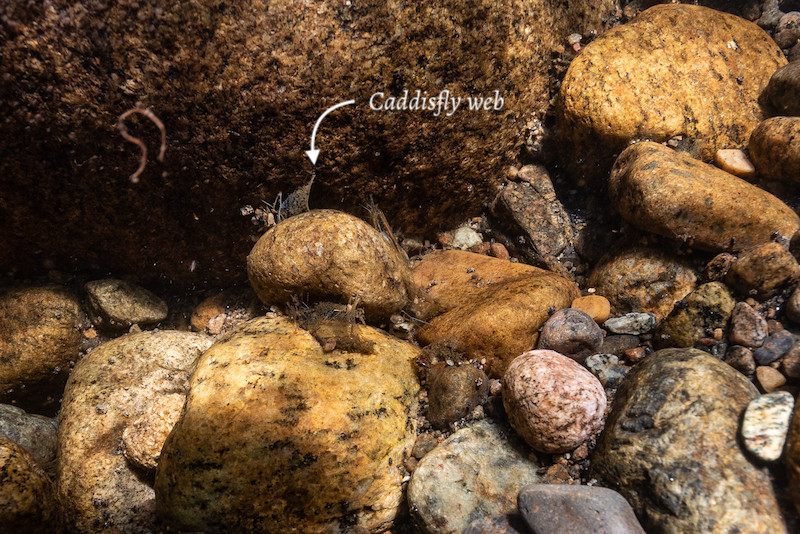Rock stacking, while seemingly harmless, can actually be detrimental to the environment; Rockscapes.net is here to explain why and offer some eco-friendly alternatives for enjoying nature’s beauty. Building rock sculptures disturbs wildlife habitats, increases erosion, and misleads hikers. Let’s explore some sustainable landscaping and outdoor recreational activities.
1. What is Rock Stacking and Why Do People Do It?
Rock stacking, also known as rock balancing or cairn building, involves arranging rocks into vertical formations. People stack rocks for various reasons, including artistic expression, meditation, spiritual connection, and simply enjoying the challenge of balancing stones. While the practice may seem harmless, it can have negative impacts on the environment.
1.1. Artistic Expression
Many people view rock stacking as a form of artistic expression, creating temporary sculptures that blend with the natural landscape. The appeal lies in the challenge of finding the perfect balance and creating visually appealing formations.
1.2. Meditation and Mindfulness
For some, rock stacking is a meditative practice that promotes mindfulness and a connection with nature. The act of carefully selecting and placing each stone can be a calming and centering experience.
1.3. Spiritual Connection
In some cultures, rock cairns have spiritual significance and are used as markers or offerings in sacred places. Building a rock stack can be a way for individuals to express their reverence for nature and connect with the spiritual realm.
1.4. Recreational Activity
Rock stacking can also be a simple recreational activity, especially in areas with abundant rocks. It offers a creative outlet and a way to engage with the environment in a unique way.
2. How is Rock Stacking Bad for the Environment?
Yes, rock stacking is bad for the environment because it disrupts ecosystems, contributes to erosion, and can mislead hikers. The environmental impacts of rock stacking often outweigh the perceived benefits.
2.1. Disruption of Ecosystems
Rock stacking can disrupt the natural habitats of various species that rely on rocks for shelter, nesting, and foraging. Moving rocks can displace insects, amphibians, reptiles, and small mammals, disrupting their life cycles and food chains.
2.1.1. Impact on Aquatic Life
In aquatic environments, rock stacking can be particularly harmful. Fish, amphibians, and invertebrates often lay eggs or build nests in the crevices between rocks. Moving these rocks can destroy their habitats and expose them to predators or harsh environmental conditions. According to research from the Ausable River Association, many fish species lay eggs in crevices between rocks, and moving them can result in altered flows, which could wash away the eggs or expose the fry to predators.
 Sunfish nests within rock crevices, showcasing the importance of undisturbed rocks for aquatic life
Sunfish nests within rock crevices, showcasing the importance of undisturbed rocks for aquatic life
2.1.2. Impact on Terrestrial Life
On land, rock stacking can disturb the habitats of insects, spiders, and other invertebrates that live under rocks. Salamanders and crayfish also make their homes under rocks, and rock moving can destroy their homes, and even lead to direct mortality of these creatures.
2.2. Increased Erosion
Moving rocks from their original locations can increase erosion, especially in riparian areas (the interface between land and a river or stream). Rocks help stabilize soil and prevent it from being washed away by water or wind. When rocks are removed, the soil becomes more vulnerable to erosion, leading to habitat loss and water pollution.
2.3. Misleading Hikers
In some areas, rock cairns are used as navigational markers to guide hikers along trails. However, when visitors create their own rock stacks, it can confuse hikers and lead them off the designated trail. This can result in lost hikers, damage to sensitive vegetation, and increased erosion.
2.4. Aesthetic Pollution
While some people find rock stacks visually appealing, others view them as a form of aesthetic pollution that detracts from the natural beauty of the landscape. The presence of numerous rock stacks can create a cluttered and artificial appearance, diminishing the sense of wilderness and solitude that many people seek in natural areas.
 Rock stacks along a river, demonstrating how such constructions can visually disrupt natural landscapes
Rock stacks along a river, demonstrating how such constructions can visually disrupt natural landscapes
3. What are the Specific Environmental Impacts of Rock Stacking on Different Ecosystems?
Rock stacking can significantly impact various ecosystems. Each environment faces unique challenges when rocks are moved or disturbed.
3.1. River and Stream Ecosystems
Rock stacking in rivers and streams disrupts aquatic habitats, affecting fish, invertebrates, and other organisms. Moving rocks can destroy spawning grounds, disrupt food chains, and increase erosion, harming overall stream health. According to the Leave No Trace Center for Outdoor Ethics, rock stacking in streams and rivers can be particularly harmful due to the sensitive nature of these ecosystems.
3.1.1. Disruption of Aquatic Habitats
Aquatic insects, such as mayflies, stoneflies, and caddisflies, rely on rocks for shelter and food. Moving these rocks can displace or kill these insects, reducing food availability for fish and other predators. Caddisflies, a favorite food of trout, utilize river rocks to build webs that catch drifting food particles.
 Caddisfly larva on a rock, illustrating how aquatic insects depend on rocks for habitat and food
Caddisfly larva on a rock, illustrating how aquatic insects depend on rocks for habitat and food
3.1.2. Impact on Fish Spawning
Many fish species lay their eggs in the crevices between rocks. When these rocks are moved, the eggs can be destroyed or exposed to predators. Additionally, altered water flow patterns can wash away eggs or disrupt the development of young fish.
3.1.3. Increased Erosion
Removing rocks from riverbeds can destabilize the banks and increase erosion. This can lead to sedimentation, which can smother aquatic habitats and reduce water quality.
3.2. Forest Ecosystems
Rock stacking in forests can disrupt terrestrial habitats, affecting insects, amphibians, reptiles, and small mammals. Moving rocks can expose these animals to predators, alter soil composition, and damage plant roots.
3.2.1. Disruption of Terrestrial Habitats
Insects, spiders, and other invertebrates often live under rocks in forests. These creatures play important roles in decomposition and nutrient cycling. Moving rocks can displace or kill these organisms, disrupting these ecological processes.
3.2.2. Impact on Amphibians and Reptiles
Amphibians and reptiles, such as salamanders and snakes, rely on rocks for shelter and thermoregulation. Moving rocks can expose these animals to predators or create unfavorable microclimates.
3.2.3. Altered Soil Composition
Removing rocks can alter soil composition and moisture levels, affecting plant growth. Rocks help retain moisture in the soil and prevent erosion. When they are removed, the soil can become drier and more susceptible to erosion.
3.3. Mountain Ecosystems
Rock stacking in mountain ecosystems can damage fragile alpine vegetation, disrupt wildlife habitats, and mislead hikers. Alpine environments are particularly sensitive to disturbance due to their harsh climate and slow recovery rates.
3.3.1. Damage to Alpine Vegetation
Alpine vegetation is adapted to survive in harsh conditions, but it is also very fragile and slow-growing. Moving rocks can damage or destroy these plants, leading to soil erosion and habitat loss.
3.3.2. Disruption of Wildlife Habitats
Mountain ecosystems provide habitat for a variety of wildlife species, including birds, mammals, and insects. Rock stacking can disrupt these habitats by displacing animals, altering food sources, and creating artificial structures that interfere with natural behaviors.
3.3.3. Misleading Hikers
In mountainous areas, rock cairns are often used as navigational markers to guide hikers along trails. When visitors create their own rock stacks, it can confuse hikers and lead them off the designated trail, potentially leading to dangerous situations.
4. How Does Rock Stacking Affect Wildlife Habitats?
Rock stacking directly impacts wildlife habitats by displacing animals, disrupting nesting sites, and altering natural shelters. The removal of rocks disturbs microhabitats critical for various species.
4.1. Displacement of Animals
Moving rocks can displace animals from their natural shelters and foraging areas. This can force them to expend energy searching for new habitats, making them more vulnerable to predators and starvation.
4.2. Disruption of Nesting Sites
Many animals, including birds, reptiles, and amphibians, use rocks as nesting sites. Moving rocks can destroy nests and eggs, reducing reproductive success.
4.3. Alteration of Natural Shelters
Rocks provide important shelter for a variety of animals, protecting them from the elements and predators. Moving rocks can remove these shelters, exposing animals to harsh conditions and increasing their risk of mortality.
4.4. Disturbance of Microhabitats
Every single rock is potentially a home to the larval stages of aquatic insects, including dragonflies, damselflies, mayflies, stoneflies, and caddisflies, and many others. They cling to rocks and capture drifting food particles. By moving and stacking rocks, the insects that are attached to or living on the rocks can be desiccated and burned by the sun.
5. What is the Impact of Rock Stacking on Soil Erosion?
Rock stacking contributes to soil erosion by removing natural stabilizers and exposing soil to wind and water. This can lead to habitat degradation and water pollution.
5.1. Removal of Natural Stabilizers
Rocks help stabilize soil by providing a physical barrier against wind and water. When rocks are removed, the soil becomes more vulnerable to erosion.
5.2. Exposure of Soil to Wind and Water
Without the protection of rocks, soil is easily eroded by wind and water. This can lead to the loss of topsoil, which is essential for plant growth.
5.3. Habitat Degradation
Soil erosion can degrade habitats by removing essential nutrients and altering soil structure. This can make it difficult for plants to grow, reducing food and shelter for animals.
5.4. Water Pollution
Eroded soil can be carried into waterways, polluting them with sediment and nutrients. This can harm aquatic life and reduce water quality.
6. How Does Rock Stacking Confuse Hikers and Affect Navigation?
Yes, rock stacking can confuse hikers because unofficial rock stacks can obscure or mimic official trail markers, leading to disorientation and potentially dangerous situations.
6.1. Obscuring Official Trail Markers
In some areas, rock cairns are used as official trail markers to guide hikers along designated routes. When visitors create their own rock stacks, it can obscure or mimic these official markers, making it difficult for hikers to follow the trail.
6.2. Leading Hikers Off Trail
Unofficial rock stacks can lead hikers off trail, especially in areas with challenging terrain or poor visibility. This can result in lost hikers, injuries, and damage to sensitive vegetation.
6.3. Increasing Risk of Accidents
Hikers who become disoriented due to confusing rock stacks are at increased risk of accidents, such as falls, slips, and encounters with wildlife.
6.4. Environmental Damage
Hikers who wander off trail can cause significant damage to vegetation, soil, and wildlife habitats. This can be especially harmful in fragile ecosystems, such as alpine meadows and riparian areas.
7. What are the Ethical Considerations of Rock Stacking?
The primary ethical consideration of rock stacking is the “Leave No Trace” principle, which emphasizes minimizing human impact on natural environments. Rock stacking often violates this principle by altering the landscape and disrupting ecosystems.
7.1. Leave No Trace Principle
The Leave No Trace principle is a set of ethical guidelines that promote responsible outdoor recreation. It emphasizes minimizing human impact on natural environments by avoiding activities that can damage or disturb ecosystems.
7.2. Altering the Landscape
Rock stacking alters the landscape by creating artificial structures that are not part of the natural environment. This can detract from the aesthetic value of natural areas and diminish the sense of wilderness.
7.3. Disrupting Ecosystems
Rock stacking can disrupt ecosystems by displacing animals, altering soil composition, and damaging vegetation. This can have long-term consequences for the health and biodiversity of natural areas.
7.4. Impacting Other Visitors
While some people may find rock stacks visually appealing, others view them as a form of aesthetic pollution that detracts from the natural beauty of the landscape. The presence of numerous rock stacks can diminish the sense of solitude and discovery that many people seek in natural areas.
8. What are Some Alternatives to Rock Stacking That Are Environmentally Friendly?
Environmentally friendly alternatives to rock stacking include nature photography, mindful observation, creating ephemeral art with natural materials, and participating in habitat restoration projects.
8.1. Nature Photography
Nature photography is a great way to connect with the natural world without disturbing it. Capture the beauty of rocks, plants, and animals with your camera, and share your images with others to inspire appreciation for nature.
8.2. Mindful Observation
Spend time observing the natural world with all your senses. Notice the colors, textures, sounds, and smells of the environment. Pay attention to the details of rocks, plants, and animals, and appreciate the complexity and beauty of nature.
8.3. Creating Ephemeral Art with Natural Materials
Create temporary art using natural materials such as leaves, twigs, and flowers. Arrange these materials into patterns or sculptures, and then leave them to decompose naturally. This is a creative and environmentally friendly way to express your connection with nature.
8.4. Participating in Habitat Restoration Projects
Volunteer your time to help restore damaged habitats. This can involve planting trees, removing invasive species, or cleaning up litter. By participating in habitat restoration projects, you can make a positive impact on the environment and help protect natural areas for future generations.
9. What is the Role of Education and Awareness in Preventing Harmful Rock Stacking?
Education and awareness play a crucial role in preventing harmful rock stacking by informing people about the environmental impacts and promoting responsible outdoor behavior.
9.1. Informing People About Environmental Impacts
Many people are unaware of the environmental impacts of rock stacking. By providing information about the ecological consequences of this activity, we can help people make more informed decisions about their behavior in natural areas.
9.2. Promoting Responsible Outdoor Behavior
Education and awareness can also promote responsible outdoor behavior by encouraging people to follow the Leave No Trace principles. This includes leaving rocks in their natural locations, avoiding disturbance of wildlife habitats, and respecting the aesthetic value of natural areas.
9.3. Engaging Communities
Engaging communities in conservation efforts can help foster a sense of stewardship and responsibility for natural areas. This can involve organizing educational events, volunteer activities, and community-based monitoring programs.
9.4. Utilizing Social Media and Online Platforms
Social media and online platforms can be powerful tools for raising awareness about the environmental impacts of rock stacking. Share information, photos, and videos that highlight the negative consequences of this activity and promote responsible outdoor behavior.
10. What are the Regulations and Policies Regarding Rock Stacking in Protected Areas?
Many protected areas have regulations and policies that prohibit or restrict rock stacking to protect natural resources and preserve the aesthetic value of the landscape.
10.1. Prohibitions on Rock Stacking
Some protected areas have outright prohibitions on rock stacking, considering it a form of vandalism or environmental damage. These prohibitions are often enforced through fines or other penalties.
10.2. Restrictions on Rock Stacking
Other protected areas have restrictions on rock stacking, such as limiting the size or location of rock stacks. These restrictions are designed to minimize the environmental impacts of this activity while still allowing visitors to express their creativity.
10.3. Enforcement of Regulations
Enforcement of rock stacking regulations can be challenging, especially in remote or heavily visited areas. However, park rangers and other staff members can play an important role in educating visitors about the rules and enforcing them when necessary.
10.4. Collaboration with Stakeholders
Effective management of rock stacking requires collaboration with a variety of stakeholders, including park managers, conservation organizations, local communities, and visitors. By working together, we can develop and implement strategies that protect natural resources and promote responsible outdoor behavior.
FAQ About Rock Stacking and Its Environmental Impact
Is Rock Stacking Always Bad for the Environment?
Yes, Rock stacking is generally bad for the environment because it can disrupt ecosystems, increase erosion, and mislead hikers. However, the extent of the impact depends on the location and scale of the activity.
Why Do People Stack Rocks If It’s Harmful?
People stack rocks for various reasons, including artistic expression, meditation, spiritual connection, and recreational enjoyment. Many are unaware of the environmental consequences.
What Kind of Animals are Affected by Rock Stacking?
Rock stacking can affect a variety of animals, including insects, amphibians, reptiles, fish, and small mammals. These animals rely on rocks for shelter, nesting, and foraging.
How Does Rock Stacking Increase Erosion?
Removing rocks from their original locations can destabilize soil and increase its vulnerability to wind and water erosion.
Can Rock Stacking Mislead Hikers?
Yes, unofficial rock stacks can obscure or mimic official trail markers, leading to disorientation and potentially dangerous situations for hikers.
Are There Any Alternatives to Rock Stacking?
Yes, there are many environmentally friendly alternatives to rock stacking, including nature photography, mindful observation, creating ephemeral art with natural materials, and participating in habitat restoration projects.
What is the Leave No Trace Principle?
The Leave No Trace principle is a set of ethical guidelines that promote responsible outdoor recreation by minimizing human impact on natural environments.
What Can I Do To Help Prevent Harmful Rock Stacking?
You can help prevent harmful rock stacking by educating others about the environmental impacts, following the Leave No Trace principles, and participating in habitat restoration projects.
Are There Regulations Against Rock Stacking in Protected Areas?
Yes, many protected areas have regulations that prohibit or restrict rock stacking to protect natural resources and preserve the aesthetic value of the landscape.
How Can Education and Awareness Prevent Harmful Rock Stacking?
Education and awareness can inform people about the environmental impacts of rock stacking and promote responsible outdoor behavior, leading to a greater understanding and respect for nature.
Conclusion: Protecting Our Natural Landscapes
Rock stacking, while often done with good intentions, can have detrimental effects on the environment. By understanding these impacts and choosing environmentally friendly alternatives, we can help protect our natural landscapes for future generations. Remember, the beauty of nature lies in its untouched state. Let’s preserve it by leaving no trace and finding sustainable ways to connect with the environment.
Looking for inspiration and expert advice on creating sustainable and beautiful landscapes? Visit Rockscapes.net. We offer a wealth of information on eco-friendly landscaping practices, the best types of natural stones to use, and tips for designing outdoor spaces that harmonize with nature. Explore our gallery of stunning landscape designs and connect with our experts for personalized advice.
Address: 1151 S Forest Ave, Tempe, AZ 85281, United States
Phone: +1 (480) 965-9011
Website: rockscapes.net
Let’s work together to create landscapes that are not only beautiful but also sustainable and respectful of the environment.
